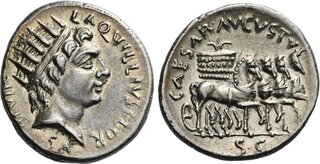| Numismatica Ars Classica > Auction 143 | Auction date: 7 May 2024 |
| Lot number: 474 Price realized: This lot is for sale in an upcoming auction - Bid on this lot  | Show similar lots on CoinArchives Find similar lots in upcoming auctions on |
| Lot description: The Dioscuri Collection. The Roman Empire. Octavian 32 – 27 and as Augustus, 27 BC – 14 AD. Roma L. Aquillius Florus. Denarius circa 19 BC, AR 19 mm, 3.81 g. L AQVILLIVS FLOR – VS III VIR Head of Sol r. Rev. CAESAR·AVGVSTVS Slow quadriga r., with modius-shaped car surmounted by three ears of corn (?); in exergue, S C. C 357. BMC 38. RIC 303. CBN 169. Very rare and in exceptional condition for the issue. A lovely portrait of fine stye and light iridescent tone. Good extremely fine Ex NAC sale 106, 2018, 547. This rare denarius illustrates not only Augustus' desire to present himself as the continuator of the Roman Republic, but also his wish to be seen as a benefactor to his. Although the traditional college of Roman moneyers-the tresviri monetales-ceased to exist by 39 BC due to civil war and the domination of the coinage by the members of the Second Triumvirate of Octavian, Mark Antony and Marcus Lepidus. However, in his efforts to restore an illusory Republican normalcy following his assumption of power as Augustus in 27 BC, Octavian briefly revived the college of moneyers, as indicated here by the obverse signed by L. Aquilius Florus, one of the moneyers for 19 BC. The obverse depiction of Sol wearing a radiate crown may perhaps subtly flatter Augustus for his universal rule, extending throughout the world like the rays of the sun, but most likely it reflects the return of the Republican tradition of moneyers employing types related to their ancestors. A very similar Sol had appeared on Republican denarii struck by Manius Aquilius almost a century earlier in 109-108 BC. Aquilius used the same obverse type for other coins struck for Augustus during his tenure as one of the tresviri monetales. The reverse type depicts a large modius (grain measure) in a chariot drawn by four horses and seems to refer to action taken by the emperor to improve the grain supply of Rome. Although he had personal reservations about maintaining a permanent annona (grain dole) distributed to the urban poor of Rome, in the interest of his public image and of stability in the imperial capital, he is known to have expanded the number of recipients from 150,000 to 200,000. In 23/2 BC, Augustus also took charge of the general grain supply to Rome during a period of shortage and at his personal expense ensured the provision of grain at reasonable prices. This successful intervention in the grain supply was considered by the emperor to be important enough to be trumpeted by Augustus in his Res Gestae. Both the Res Gestae and the coin type, however, fail to indicate that before action was taken the hungry people of Rome were rioting in the streets and threatening to burn down the Senate House if Augustus was not granted authority to intervene. The fact that he was able to resolve the shortage in a matter of days has led some commentators to suspect that the grain shortage was actually created by Augustus for the purpose of turning the people against the Senate and being seen as the hero to end the crisis. Estimate: 6000 CHF |  |



